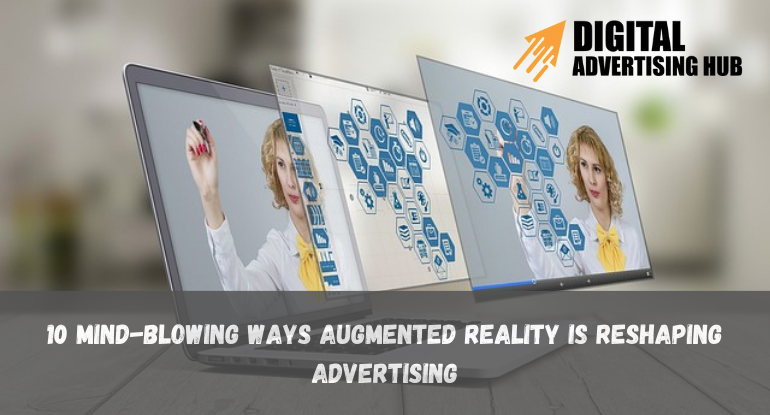Advertising undergoes perpetual evolution, with augmented reality (AR) standing tall among its most thrilling advancements. Originally confined to the gaming field, AR has now surged into the advertising sphere, instigating a transformative wave.
It seamlessly intertwines the digital field with reality, crafting immersive encounters that grip and enthrall audiences in unprecedented ways.
This technological marvel isn’t just a trend; it’s a paradigm shift. AR’s ability to merge virtual and tangible spaces elevates advertising into a realm of unparalleled engagement and captivation, altering the landscape of consumer interaction.
What is Augmented Reality?

Augmented Reality (AR) is a technology that overlays digital information, such as images, videos, or 3D models, onto the real world. It blends the physical environment with computer-generated elements, enhancing the user’s perception and interaction with their surroundings.
AR typically utilizes devices like smartphones, tablets, or special glasses to superimpose digital content onto the real world in real-time.
Unlike virtual reality (VR), which creates a completely immersive simulated environment, AR enhances the real-world environment by adding computer-generated elements, making it possible to interact with both the digital and physical worlds simultaneously.
This technology has applications across various fields, including gaming, education, healthcare, retail, marketing, and more, offering unique experiences and practical solutions by merging the digital and physical realms.
Here are 10 mind-blowing ways AR is reshaping advertising:
#1. Interactive Product Visualization
Augmented Reality (AR) has fundamentally transformed the way consumers interact with products before making purchase decisions. One of its groundbreaking applications is the realm of interactive product visualization, which revolutionizes the traditional shopping experience.
Imagine browsing an online furniture store and stumbling upon a couch that catches your eye. In the past, making a decision about purchasing it would involve guesswork about how it might fit into your living room.
But with AR, that guesswork is eliminated. Companies now offer consumers the ability to virtually place that couch in their own living space using their smartphone or tablet.
By simply pointing the device at the area where the couch would go, an accurate 3D rendering of the furniture appears in real time. This allows customers to see exactly how the piece fits in terms of size, color, and style, eliminating the uncertainty that often accompanies online furniture shopping.
Likewise, AR has revolutionized the fashion industry by enabling virtual try-ons. Instead of merely browsing through clothing options online, consumers can now virtually “try on” different outfits using AR-powered apps.
By superimposing digital clothing onto their own image in real-time through the device’s camera, shoppers can see how clothes fit, how they look from different angles, and how they complement their personal style, all without stepping into a dressing room.
This interactive experience not only boosts confidence in purchasing decisions but also enhances engagement by providing a personalized, immersive shopping journey.
The impact of this interactive product visualization is profound. It transcends the limitations of traditional online shopping by bringing the store experience directly into the consumer’s home.
It bridges the gap between the digital and physical worlds, allowing customers to make more informed decisions and significantly reducing the likelihood of post-purchase disappointment.
Moreover, this technology doesn’t just benefit consumers, it’s a game-changer for businesses too. By offering AR-based product visualization, companies can significantly decrease return rates, as customers have a clearer understanding of what they’re buying.
This, in turn, improves customer satisfaction and loyalty while reducing operational costs associated with returns.
#2. Engaging Storytelling
Augmented Reality (AR) has ushered in a new era of storytelling for brands, offering a captivating and immersive way to connect with audiences. By seamlessly blending digital content with the real world, AR enables brands to transcend the limitations of traditional advertising and create narratives that truly resonate.
Imagine walking down the street and encountering an AR advertisement for a travel company. As you look through your smartphone or AR-enabled device, the scenery around you transforms.
Suddenly, you’re transported to the sandy beaches of a tropical paradise or standing at the foot of a majestic mountain all through the magic of augmented reality. This immersive experience instantly grabs your attention, making the advertisement more than just a message but a journey that you’re a part of.
AR storytelling isn’t limited to travel ads; it extends across various industries. For example, in the entertainment industry, movie promotions can leverage AR to transport users into the world of the film. By scanning a movie poster, users might see characters leap out in 3D or unlock exclusive behind-the-scenes content, creating excitement and anticipation.
Moreover, AR storytelling isn’t just about visual effects—it’s about interaction. Brands can craft narratives where users actively participate, solving puzzles, interacting with characters, or unlocking hidden elements in the physical environment. This interactivity deepens engagement and creates a memorable experience that consumers are more likely to share and talk about.
One of the most powerful aspects of AR-enhanced storytelling is its ability to evoke emotions and create lasting impressions. By overlaying digital elements onto the real world, brands can tug at heartstrings, trigger nostalgia, or inspire awe, forging a stronger connection with the audience. These emotional connections are what make advertisements memorable and impactful long after the initial interaction.
Additionally, AR storytelling opens up new avenues for creativity. Advertisers can experiment with unconventional narratives, blur the lines between reality and fantasy, and create experiences that leave a lasting imprint on the viewer’s mind.
#3. Gamification of Advertising

The gamification of advertising involves integrating game-like elements into advertisements, especially through the use of Augmented Reality (AR). By blending the engaging aspects of games with advertising content, brands can create interactive and enjoyable experiences for their audience.
Through AR technology, brands have the opportunity to design and implement various game mechanics, challenges, or interactive elements within their ads.
For instance, they can develop mini-games, puzzles, or quests that users can engage with while experiencing the advertisement. These games or challenges can be directly related to the brand or product, offering a fun and immersive way for users to interact with the advertised content.
By incorporating gamification into AR-powered ads, brands can achieve several objectives:
#1. Increased Engagement: Games and interactive elements naturally attract users’ attention, encouraging them to spend more time interacting with the ad. This prolonged engagement can significantly impact brand recall and message retention.
#2. Enhanced Brand Interaction: When users actively participate in these gamified experiences, they form a deeper connection with the brand. This interaction goes beyond passive viewing, fostering a more memorable and meaningful brand experience.
#3. Encouraging Consumer Participation: Challenges or games within ads can prompt users to take specific actions, such as sharing the experience on social media, visiting a physical store, or exploring additional content. This active involvement promotes desired consumer behaviors.
#4. Creating Memorable Experiences: Gamification through AR creates memorable moments for users. When brands succeed in providing entertaining and enjoyable experiences, users are more likely to remember the brand positively.
#4. Location-Based Advertising
Location-Based Advertising in the realm of Augmented Reality (AR) leverages a user’s geographical location to deliver highly targeted and personalized advertisements.
Through the utilization of geolocation technology, businesses can precisely target consumers based on their current physical position.
Here’s how it works: AR, combined with geolocation data, allows brands to superimpose digital content onto the real world in a way that’s relevant to a user’s specific location.
For example, someone walking down a street might receive AR-enabled ads on their mobile device that are specific to nearby businesses, landmarks, or points of interest.
By harnessing this technology, businesses can provide users with tailored promotions, offers, or information that are contextually relevant to the area they are in.
For instance, a user walking past a coffee shop might receive an AR advertisement offering a discount on their next purchase, enticing them to step inside. Or, in a tourist area, an AR ad might showcase information about nearby attractions or events.
The key advantages of location-based AR advertising include:
#1. Enhanced Relevance: Delivering ads based on a user’s location ensures that the content is highly relevant to their immediate surroundings. This relevancy increases the likelihood of capturing the user’s interest and engagement.
#2. Improved Targeting: Geolocation technology allows businesses to target specific geographic areas or demographics, ensuring that advertisements reach the most relevant audience for their products or services.
#3. Increased Effectiveness: Contextual advertising, tailored to a user’s location, tends to be more effective in driving action. Users are more likely to respond positively to offers or information that align with their current location and needs.
#4. Better User Experience: Instead of generic ads, users receive content that feels personalized and valuable, enriching their experience with the brand and potentially leading to higher conversion rates.
#5. In-Store Experiences:
Retailers have the opportunity to elevate in-store experiences by utilizing Augmented Reality (AR).
By incorporating AR technology into displays or dedicated apps, customers can gain access to a wealth of supplementary product details, exclusive promotions, and even virtual guidance as they move through the store.
This integration of AR creates an immersive shopping environment, enriching the overall experience for shoppers.
#6. Branded Filters and Lenses
Social media platforms such as Snapchat and Instagram provide users with the ability to engage with AR filters and lenses that are tied to specific brands.
Businesses can take advantage of this feature by developing custom filters tailored to promote their products or marketing campaigns.
This strategy significantly boosts brand exposure among social media users, leveraging the interactive nature of AR to enhance visibility and engagement.
#7. Print and Outdoor Advertising Reinvented
Augmented Reality (AR) has revolutionized traditional print and outdoor advertisements, infusing them with a fresh, interactive dimension.
Through the simple act of scanning a print ad or a billboard using a smartphone, users gain access to a world of interactive content, including videos or 3D models.
This innovative approach bridges the previously separate realms of physical and digital advertising mediums, creating a seamless and engaging experience for audiences while amplifying the impact and reach of these advertisements.
#8. Enhanced Customer Engagement
Advertising campaigns integrated with Augmented Reality (AR) facilitate heightened customer engagement, resulting in significantly increased interaction rates.
The immersive and interactive elements within AR experiences captivate users, encouraging them to invest more time in exploring and interacting with the content.
This extended engagement not only boosts brand awareness but also enhances the retention of the brand’s message within the audience, creating a more impactful and memorable advertising experience.
#9. Data Collection and Analytics

AR advertising serves as a valuable avenue for gathering pertinent data regarding user behaviors and preferences. This collected information becomes a treasure trove for insightful analytics. By looking into this data, advertisers gain crucial insights that enable them to fine-tune their advertising strategies.
They can personalize content more effectively, tailoring it to specific audiences, and utilize these insights to optimize future campaigns for enhanced results and higher efficiency.
Ultimately, this data-driven approach empowers advertisers to make informed decisions, refining their tactics to better resonate with their target audience.
#10. Future Innovations
The horizon for AR in advertising stretches endlessly. As technology continues to evolve, the possibilities for innovative AR applications within advertising are boundless.
Anticipate groundbreaking advancements like the integration of AR with wearable devices, pushing the boundaries to blur the distinction between physical reality and digital content even further.
These developments promise to usher in an era where immersive advertising experiences seamlessly intertwine with everyday life, opening new avenues for brands to engage audiences in ways previously unimagined.
Conclusion
Augmented reality is undoubtedly reshaping the advertising landscape, offering immersive, interactive, and highly engaging experiences for consumers.
As businesses continue to explore its potential, AR will play an increasingly pivotal role in delivering compelling and effective advertising campaigns that leave a lasting impression on audiences.
The fusion of technology and advertising through AR marks a new era where creativity knows no bounds, and brands can connect with consumers in ways previously unimaginable.
Embracing this transformative technology will not only redefine advertising strategies but also set new standards for engaging and impactful brand communication in the future.






